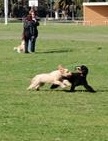Social Behaviours
How Do Animals Interact?
Learn more about their social behaviours.
Some animals are disposed to be social: the members of the group are essentially independent, each forming a specialised function which contributes to the overall survival and functioning of the group. In such groups, the member animals are polymorphic (ie. specialised structurally). Some of the best examples of such animal societies can be found with insect colonies, such as ants and bees. A behaviour which is unique to such societies is that an individual will sacrifice itself for the survival of the group (eg. Worker bees die after stinging).
Advantages of Social Living
-
The interacting group can be more successful than the lone individual. E.g. Providing protection, defence, sharing tasks such as hunting
-
Metabolism works better when animals are grouped. E.g. Sharing body heat by sleeping together, some secretions from social animals will stimulate or inhibit growth…and when a lot of animals are grouped together, the concentration of the secretion is stronger.
-
Learning and imitating behaviour is enhanced when there are more animals of the species to be observed and imitated.
-
Social life reduces aggression, competition, conflict and competition between individuals, thus promoting the survival of both the individuals and the whole species.
The social behaviour of insects and vertebrates are very different. Within insect societies, behaviour is wholly predetermined by genetics. The role of the animal is predetermined by its polymorphic condition when it begins life. It is never free to pursue a different role beyond that predetermined by its genetic makeup. Its responsibilities to the group and the group’s responsibilities to the individual are fully defined at all times. In social insects (termites, bees, ants and wasps) reproduction in the group revolves around a single fertile female – the queen, and the whole social population consists of her own immediate family which is sterile. Her genes alone are passed on to the next generation and the survival of the group is dependent on her successful reproduction. As a consequence, internal social conflicts never arise.
Within vertebrate societies, apart from sexual differences (male or female), all members of the society have basically the same structure. The social structure and roles that develop within the vertebrate society will be determined by differences in size, strength, intelligence, emotions and other such characteristics which may develop according to experience and learning, as much as due to genetic characteristics. Unlike a social insect, a social vertebrate has to find its own position in the society, and it usually must do so in direct competition with other members of the group.
Aggression
Aggression is seen in vertebrate groups through both threatening displays as well as actual fighting. The position of an animal in a group, and its access to such things as space, food and mates, with be determined through displays of aggression. Displays of aggression may be focussed upon members of either the same species or other species. The capacity to behave aggressively (or submissively) is inherited but the actual techniques used are learned through experience and imitation.
The Flight or Fight Response
Animals (like humans) have instinctive reactions that help them to deal with threats. These reactions help when the animal is threatened and must either run from, or fight with, the danger with which it is confronted. Animals can't always just fight or flee they must learn to cope with everyday torments.
Whenever the body prepares itself for a fight or flight response, it causes stress to the body. Excessive or prolonged exposure to these stimuli may have damaging effects on the body caused by constant stress. Changes in the physiological processes that alter resistance to disease (eg. blood chemistry changes) and pathological changes (eg. organ system breakdown) are both manifestations of stress.
A body’s defence mechanisms may be affected both directly and indirectly (by promoting behaviours that weaken these mechanisms or that lead to exposure to pathogens). It has been found that animals under stress may be less active (eg. eat less, exercise less). This in turn can have other effects such as reduced milk production in females.
Social Constraints
All societies have social constraints that minimise individual aggression and thereby prevent disruption to the group. The need to have a set of constraining rules is inherited, but their application is largely learned.
There are two types of social constraints in vertebrate societies:
Dominance hierarchies - where the members are ranked according to status, usually determined by size and strength. Members are able to identify the social rank of other individuals using sight, play, sniffing, greeting rituals, body postures and colouration patterns. The pecking order displayed by hens is an example of a dominant hierarchy.
The top-ranking individuals claim the choicest territory, food and mates. Internal conflicts frequently arise as lower status animals challenge the dominant ones but overall the rank system works for the group as a whole. If food is scarce, dominant members eat the available food, ensuring at least that some animals survive. Similarly, the dominant members are most likely to be the healthiest and best able to look after their offspring (and pass on their genes to the next generation).
Territoriality - where the available territory is divided into domains occupied by individuals, families or larger groups. The boundaries are identified and protected from intruders by scent markers, intensive patrolling, vocal displays and aggression. Territories reduce competition over food supplies, they enable long-term occupation of an area, and they facilitate population control.
Learn more about animal behaviour -click to see our animal behaviour course
[16/01/2025 01:31:54]